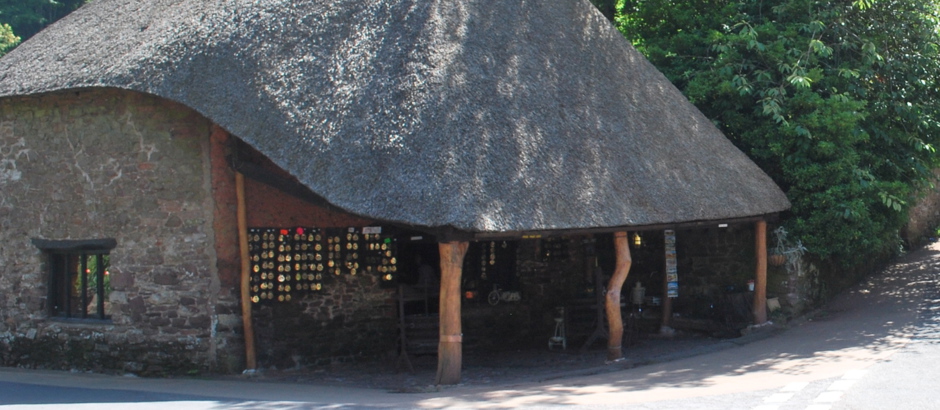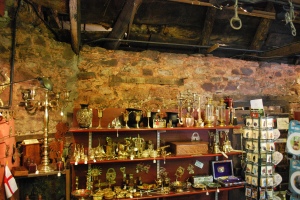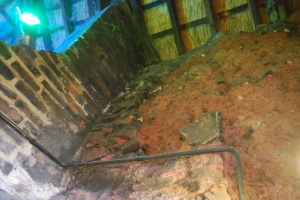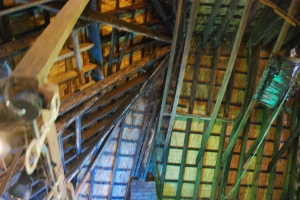
History and Articles
Now home to a flourishing arts and crafts centre, idyllic tea rooms, and unique gift shops, Cockington is an attraction that is known worldwide, and yet, being situated only a mile from Torquay, it's still an unexpected treat for travellers to stumble across.
The Forge has stood at the heart of the village for centuries, and any visitor can see how it's earned its reputation as being one of the most photographed buildings in the country. Although often
cited as being constructed in the 14th century, a forge had been on the site before that. In 1345 a fire destroyed large sections of the building, causing it to be re-built in the style you see
today, so it was actually re-constructed in the 14th century. It is thought that Rose Cottage, now a popular tea rooms, was the traditional home of the blacksmith, and was passed on along with the
forge. The first records of the forge's blacksmiths start with a Mr Davey in 1615, whose daughter married his apprentice. From there, however, it is difficult to track down any other occupants. We
know that the last blacksmith started working at the forge in the late 1940s, and held the position until 1971, when under the economic strain of a steadily decreasing workload, it was forced to
close.
Our passion doesn't end with The Forge. We love all of Cockington. And we , and so here's an assortment of bits and pieces that we've dug up. If you know anything we don't, or just fancy a chat about the village and it's history, please pop by (either in person, or via email). We're super friendly.
What's In A Name?
Jo Connell describes how the name Cockington can be broken up to reveal its origins. The name refers to the deep red colour colour of Torbay’s soil.
It’s partly Celtic:
Coch = red
and partly Anglo-Saxon:
Ing = meadow Ton = enclosure or settlement
Coch-ing-ton = ‘The Settlement of the Red Meadow’.
If These Walls Could Talk...
Although the forge is said to have existed since the 11th century, much of its structure can be firmly dated at 1345, when a fire destroyed large parts of the building. It seems likely that the front wall pre-dates the fire, being the only wall to be made almost entirely of cob, a building material made up of clay, sand, straw (which sticks out in places), water, and earth, and a popular choice for homes in the village.
Despite its age it is remarkably durable, having survived for centuries with only a few brick and cement fillings to bolster it up.
The other three later walls have had various re-building projects done to them, to such an extent that they look as though they’ve all been built in different styles. Opposite the cob, the far wall appears to be the second oldest, having been constructed with stones and rough cob-like cement. Between the stones the wall is a reddish-pink colour, lighter than the cob but coloured this way for the same reason. Earth used in the construction has been taken from the local Torbay area, where the soil is a deep red colour due to iron compounds in the ground. It is a striking feature of South Devon, and you might see it in some of the older cottages.
The wall to the right of the door is as much a mixture as the rest, with the front corner retaining its cob structure, and the rest a mixture of rough stone with a cob-styled cement, smoother stone and modern cement, and a neater brick wall that starts at the base of the chimney and stretches to the far wall.
The left hand wall is the result of the most recent re-building project. It’s actually largely split in two, with the outer half retaining its original cob and stonework, and the inside being held up with solid cement. Above this there’s neater stonework.
So the forge is actually a real hotch-potch of ages. The roof, however, is a little easier to define, although the exact age is not known. Its immense height, coupled with the layers upon layers of thatch, place an enormous strain on the building, no doubt a big factor in its numerous re-building projects. We’ve had to replace the older posts out on the courtyard twice now, and found them split and rotten inside. We’ve also added a further one to take more of the weight.
The roof is 100% waterproof, although not bird, stray branch, or spider-free. We often have to do some gardening where roots and vines climb in above the cob around the till. We have some loyal House Martins which return to us in the springtime, and leave again come autumn. There are bin liners fixed to the beams below their nest to minimise the risk of customers being hit with their droppings, although this is more likely to happen in the court area during the summer, when they sit on a bar hanging out from the gap where they make their nest.
Beneath the thatch the roof is supported by a series of beams, some reaching up, and others crisscrossing just above head level, and more higher up. You can still get a unique view of the roof.
So accurately dating the forge is more complicated than you might think. We can confidently say that most of the existing fabric is a result of the 1345 fire, and that the front cob wall is the major remnant of further back.
Saxon Cockington
The Domesday book suggests that Cockington was a Saxon settlement, if not even older– there is evidence of Celtic activity in the area, and going even further back, neolithic stone tools were found at Chelston Towers. One look around the valley that stretches from the seafront, and you can see that this was perfect land in which to settle. The stream that now trickles through the village was once large enough for the Saxons to sail up and beach their boats before exploring inland. They would have been greeted by an abundance of fertile ploughland and forests stocked with timber, ideal for building a settlement. In the late 800s Devon was split into ‘Hundreds’ (either one hundred men fit for battle or one hundred families) and Cockington fell into the Hundred of Haytor. From the Domesday Book of 1086 we know that Cockington manor was owned by a wealthy Saxon named Alric, who also owned 23 other manors in Devon. Back then Cockington was much larger, and also included Livermead and Chelston. His fate is not recorded, but it seems likely that Alric either fell at The Battle of Hastings in 1066, or died protecting his lands. It is thought that by the time the mail-clad Normans invaded, there was a manor house, chapel and estate on the land.
Source: Old Cockington, by Joan Lang.
The De Cockington Family
When the South-West eventually yielded to the Normans around 1070, Cockington was taken from the Saxon Alric, and given to William de Falaise. It was already a flourishing estate, and had a bustling harbour jutting off from Livermead. The estate found its way into the Fitz Martin family, who fancying the village’s title, took Cockington as their surname. They were also the lords of Dartington. Successive generations of the de Cockington family held the manor for the next two hundred and twenty years. During this time Torre Abbey was founded, and the de Cockingtons were known to be good friends with the White Canons, a Catholic religious order, who were allowed to cut rock from the quarry at Corbyn’s Head. In 1317 they were given the rights to fish at Livermead, and draw water from the Sherwell Stream. In 1297 King Edward granted Cockington the right to hold markets, and host a three day fair at the festival of the Holy Trinity. Like the families that succeeded them, the de Cockingtons were important figures in Devon, serving as Sheriffs, MPs, or Collectors of the King’s Taxes for the county. James de Cockington was the final member of the family to hold the estate. Like many of the village’s lords, James owned other lucrative properties and lands in Devon, namely Exeter Castle and the Port of Dartmouth. Although not written in local records, it is widely thought that in 1348 much of the family were struck by the Black Death. Their graves can be found at Torre Abbey.
The Cary Family 1371-1654
Having owned many iconic properties in Torbay, the Cary family are probably the best known Lords of the estate, and many of the village’s heirs were notable figures. After the de Cockingtons diminished, the village passed through members of the Wodeland family, before it was sold to William Cary, who like James de Cockington, served as an M.P. for Devon. In 1381, his brother, Sir John Cary, who later became Lord Baron of the Exchequer, took over the estate. From the quaint village of Kari (Clovelly) in North Devon, John also served with his brother as an M.P. Being a royalist, and keen to be riding alongside King Richard 11, it seems that he never actually took residence at Cockington. Before he took over the estate he was entrusted by the king with defending South Devon against the threat of French pirates, and this no doubt brought the beauty of Torbay to the attention of the family. Despite his strict royalist siding, he was sentenced to death for suspected treason, although he was eventually exiled to Waterford in Ireland, where he survived on £20 a year and forbidden to stray more than two miles from the town. Cockington and all of John’s possessions were confiscated, and despite his son Robert’s petitions, the land was held by John, Earl of Huntingdon, and then by Sir Robert Chalonus. Cockington was not lost for the Carys though, and in 1418 Sir Robert finally won them back in an extraordinary way. When a infamous knight from Aragon came to England looking for a warrior that could match his rank and skills, Robert bravely fought him and won. King Henry V was so impressed he granted some of his father’s land back, including Cockington.
All was quiet for a few Cary generations before the family were in the tumult of the War of the Roses. A Sir William Cary had all his lands taken by Parliamentary forces for joining the King’s enemies. Along with other south-west noblemen, William had formed an army and in 1471 marched to the Battle of Tewksbury, fighting for the Red Rose of Lancaster. He was captured by the Yorkists after the battle, and although he had received a royal pardon, he was beheaded on the battlefield. Sir Thomas Bourghier was another in a growing line of benefactors of Cary misfortune, and held the land until 1485, when it was again returned to the Cary family. With the Lancastrian victory at Bosworth, another Sir Robert Cary was free to move from Clovelly, and claimed Cockington and his title. Unlike the generations before him he was not interested in politics, and perhaps this is why he lived a long and productive life on his southern estate, even completeing a pilgramige to Compostela, Spain, at the age of sixty-one. He funded restorations to the church, and gave the then brightly coloured font. He returned from his travels and later died at Clovelly.
Next up came Sir George Cary, renowned for his defence against the Spanish Armada. Like most of the Carys before him, he was an exceptional lawyer, and later an M.P. and could count Queen Elizabeth among his admirers. He helped complete the defensive structures at Dover Castle, and along with Sir Edward Seymour of Torre Abbey, raised and commanded a 1600 strong force from South Devon. In 1588, Sir George and Sir John Gilbert of Compton Castle brought in the beaten Spanish galleon, Capitania, and held 400 men in the barn at Torre Abbey, although the two later fell out because Sir John employed 140 of the men to work in the grounds of his castle. Sir George was knighted and became Lord Deputy of Ireland, and later Treasurer of Wars, an honoured position paying £638, one of the best salaries in the country. After six years he retired to spend his days ‘to God and himself’. In 1607 he returned and married fifteen year old Lettice Rich. Before his death in 1617 he built seven almhouses. He’s now burried in a vault in Cockington church. The last Cary was Sir Henry, who served as Sheriff of Devon, and after raising a regiment for the King during the Civil War, was knighted by Charles 1st at Crediton. The end came when he surrendered Kingswear castle, despite commanding twelve guns with twelve barrels of gunpowder. He was pardoned but fined heavily, and forced to sell the estate. He sold Cockington in 1654 for £10,000 to Roger Mallock, a goldsmith of Exeter. Another branch of the Carys later held on to Torre Abbey until the 1930s, but Cockington had firmly passed into the final family owners. Sir Henry emigrated to Virginia in America, where his children fought in the American Civil War. He returned, however, and was dependant on charity until his death.
The Mallock Family (1654-1932)
The Mallocks were the final family to hold the estate, and compared to the previous tenants, left a dramatic impact on the buildings of Cockington, and through often humorous letters and recordings, are the most accurately preserved owners. They were to own Cockington for nearly three hundred years. The son of Roger, Rawlyn, ‘new builded the house, enclosed the park, walled around a warren and large gardens, filled up the ponds and made it as gentile and commodious a dwelling as most in the county’ so it seems that the estate had fallen into disrepair. His initials and the date, 1673, are inscribed on the south wing. Many of the features we see today were due to Richard. He enlarged the manor house, which was previously thatched, and carved out the spacious gardens. He also walled off a large area to create a rabbit warren. Famously, Rawlyn was among a handful of men who greeted William of Orange when he arrived in Brixham. Unlike the Carys, the Mallocks line of succession was rarely as simple as father-to-son, with the property being handed to more distant relatives. Perhaps this is why the new owners had no problems drastically changing the grounds. After Rawlyn, Cockington passed to a cousin, who like most of the male Mallocks was also named Rawlyn. He was known locally as a smuggler, and allowed goods to be hidden in his barns.
Next came the Mallock that most dramatically changed Cockington. Reverend Roger became the squire of the Cockington aged just fourteen and held the estate for sixty years. He turned the deer park into rented farmland, which brought in more money. In 1820 he removed all the outbuildings close to the court, most of them over a hundred years old, including the Cary’s seven almhouses which were rebuilt elsewhere. He built the pillars either side of the main entrance, but also lowered the roof of the court and constructed skylights. It seems he recycled the new entrance pillars from elsewhere in the house, as they contain the Cary coat of arms, although this section has been cut out and reversed, hiding the emblem. The reverend must have been conscious of his money, as some windows were boarded up, probably to avoid the window tax introduced in 1697. Under the tax all homeowners with more than six windows had to pay more than smaller dwellings. It was abolished in 1851. Jo Connell’s Cockington, contains a quote from a later resident W.H Mallock: ‘A hall with minstrels gallery was turned by him into several rooms as commonplace as it is possible to imagine. Indeed little of special interest survived him.’ The Reverend’s unpopular building projects did not end there. By the 1830s Torquay had grown into an important harbour town and the new seafront road encouraged visitors to stray into the family territory. The reverend was so put out by this that he had the road from the bay diverted from his land, and a lodge built to confirm the boundary. Not much is recorded about the following Mallocks, until 1900 when Charles Herbert Mallock inherited Cockington.
A captain, later a major, Charles Mallock served in the royal artillery. He must have been a popular owner, as on his return from service in 1906 the village’s inhabitants hosted a band, fireworks, and even a line of fairy lights stretching from Higher Lodge to the manor house. Charles left the tranquility of the estate and rejoined his regiment at the outbreak of war in 1914, and was awarded the D.S.O. Tragically, he was killed by German mustard gas at Ypres in 1917, leaving behind a ten year old heir. Cockington was leased to J.H Charlesworth until 1928, when Richard Herbert Mallock was old enough to inherit the estate. The village and grounds were becoming increasingly popular with tourists, and in order to get some further privacy, Richard erected and locked a gate at the main entrance to the court grounds. However, the villagers must have been confused when they next gathered for church, the church being situated next to the court, meaning they could see it but not get to it. Although the Cockington Parish Church owned the building, Richard Mallock owned all the land around it. With Richard unwilling to back down, the Chancery Division of the High Court got involved and issued an order that gave access to pedestrians between 9 a.m and 6.30 p.m every day. By this time the Mallock’s time in Cockington was coming to an end, and in 1932 Richard sold the estate.










